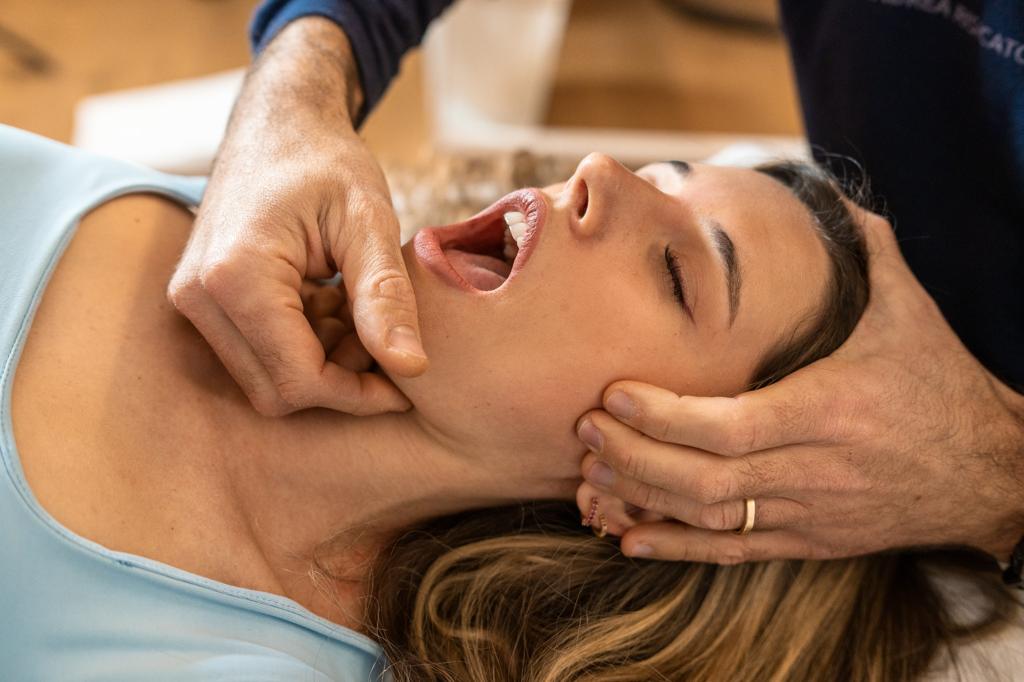Ever had a stiff jaw or felt pain when chewing? It could be a sign of TMJ disorder (TMJD), and TMJ massage might help. This joint, found near your ears, links your lower jaw to your skull and plays a key role in chewing. When it doesn’t work properly, it can cause discomfort not only in your jaw but also in your neck, shoulders, and face.
Research shows that around 20-40% of adults experience TMJD symptoms, but there’s good news—massage can provide relief. By targeting specific areas, massage helps ease tension and manage pain. Curious to know how massage can help? Let’s explore how TMJ massage could bring you comfort.
Recognising TMJ Dysfunction: Common Symptoms
Before we dive into treatment options, it’s essential to recognise the signs of TMJ dysfunction (TMJD). Common symptoms include:
- Jaw pain or tenderness
- Difficulty chewing or speaking
- Popping or clicking sounds when moving the jaw
- Stiffness in the jaw, neck, or shoulders
- Headaches and earaches
If you’re experiencing any of these symptoms, exploring options like massage and TMJ exercises can help you find relief.
The Power of TMJ Massage for Pain Relief
Can massage really help with TMJ pain? Absolutely. TMJ massage is proven to relax tight muscles around the jaw, improve blood flow, and alleviate tension. This can help improve the range of motion in your jaw and reduce pain.
TMJ muscles, including the masseter and temporalis, are frequently affected by stress, teeth grinding, and poor posture. Massage therapy can target these areas, easing discomfort and promoting healing.
Finding TMJ Trigger Points
Trigger points are sensitive areas in muscles that can cause pain when pressed. These are commonly associated with TMJ dysfunction, contributing to jaw discomfort and tension. Some of the most common TMJD trigger points include:
- Masseter muscle: Found near your cheekbone and jaw, often causing headaches and jaw pain.
- Temporalis muscle: Located on both sides of your head, near your temples.
- Suboccipital muscles: Found at the base of your skull, linked to neck stiffness and tension headaches.
- Sternocleidomastoid muscle: Runs along the front of your neck, contributing to neck and shoulder pain.
Massaging these trigger points can help relieve pain, ease tension, and improve overall jaw mobility.
DIY TMJ Massage: Techniques You Can Try at Home
If you’re experiencing TMJ discomfort, you don’t always need to see a professional. There are several effective self-massage techniques you can easily try at home to help relieve pain and tension. Here are some of the best methods:
Masseter Cross Fibre Massage
- Make fists and place your knuckles just beneath your cheekbones.
- Apply firm pressure and gently move your knuckles in small, circular motions.
- Do this for 30-60 seconds, both with your mouth open and closed.
- This technique targets the masseter muscle, which is often a source of jaw pain, helping to reduce tension and improve mobility.
Suboccipital Friction Massage
- Use your thumbs to gently rub the base of your skull in circular motions.
- This technique is excellent for relieving neck tension that’s often linked to TMJ issues, particularly if you experience headaches or stiffness in the neck.
- Massaging the suboccipital muscles can also help release tightness that contributes to TMJ discomfort.
Masseter Kneading
- Locate the masseter muscle by placing your hands on your cheeks and clenching your jaw. The muscle will become more pronounced.
- Gently grab the muscle and knead it by moving it slightly away from your face, then side to side.
- This method improves blood flow to the muscle, which can reduce pain and improve jaw flexibility.
These exercises are safe to perform daily and can help keep your TMJ muscles relaxed, reducing discomfort over time. Self-massage is a simple yet effective way to manage TMJ pain and improve jaw mobility. Always listen to your body, and if symptoms persist, consider consulting a professional.
Effective Jaw Exercises for TMJ Relief
In addition to TMJ massage, gentle jaw exercises can help strengthen the muscles around the temporomandibular joint. Here are a few effective TMJ exercises:
1. TMJ Opening Stretch
- Place your tongue on the roof of your mouth.
- Slowly open your mouth as wide as possible without causing discomfort.
- Hold the position for a few seconds before closing.
2. Resisted Mouth Opening
- Use your thumb under your chin to apply light pressure as you try to open your mouth.
- Hold for 5 seconds before releasing.
- Repeat this exercise 5 times.
These simple TMJ dysfunction exercises can be performed daily to improve mobility and reduce stiffness.
When to Consult a TMJ Specialist
While self-massage and exercises can help alleviate minor symptoms, more severe cases may require professional intervention. If your TMJ pain persists or worsens, it may be time to consult a TMJ specialist. A specialist can provide tailored TMJ dysfunction physiotherapy to target the underlying causes of your condition.
TMJ physio often includes advanced manual therapy, ultrasound treatments, and other modalities to treat the disorder effectively. Seeing a qualified professional is crucial if you experience chronic pain, difficulty opening your mouth, or ongoing headaches.
The Benefits of Professional TMJ Massage
While self-massage can offer relief, the benefits of professional TMJ massage are unmatched. A trained therapist has the expertise to work deeply into your TMJ muscles, identifying the root cause of your discomfort and providing targeted treatment.
One key advantage of seeing a professional is their ability to perform intraoral massage, which targets the muscles inside the mouth that are difficult to reach with self-massage. This technique can effectively relieve tension in muscles like the masseter and pterygoid, which play a significant role in jaw movement and often contribute to TMJ pain.
When seeking treatment, it’s important to find a registered massage therapist or TMJ specialist with experience in temporomandibular joint massage. Your dentist or physiotherapist may be able to recommend someone qualified.
Professional TMJ massage can reduce pain, improve mobility, and help prevent recurring issues. If your symptoms persist despite at-home treatments, a professional massage might be the next step towards long-term relief.
TMJ Dysfunction Physiotherapy: What to Expect
TMJ dysfunction physiotherapy focuses on improving joint function, reducing muscle tension, and preventing further injury. In addition to temporomandibular joint massage, your physiotherapist might recommend:
- Temporomandibular joint disorder exercises: To strengthen weak muscles and increase flexibility.
- Manual therapy: To mobilise the jaw and improve its range of motion.
- Postural training: Poor posture can contribute to TMJD, and improving your posture can help relieve strain on the jaw.
If you’re dealing with persistent TMJ issues, physiotherapy can be a game-changer in managing your symptoms.
Lifestyle Changes to Manage TMJ Pain
Managing TMJ pain isn’t just about massage and jaw exercises. Lifestyle changes can also help reduce tension and prevent flare-ups. Some tips include:
- Avoiding chewy or hard foods that strain your jaw.
- Maintaining good posture to relieve tension in the neck and shoulders.
- Practising relaxation techniques like diaphragmatic breathing to reduce overall stress.
By incorporating these habits into your daily routine, you’ll be better equipped to manage your TMJD symptoms.
Exploring Massage Tools for TMJ Relief
While hands-on techniques are effective, some people find additional relief using massage tools. Massage chairs, for instance, can help relax the neck and shoulder muscles, indirectly benefiting TMJ tension. However, it’s important to note that these tools should complement, not replace, targeted TMJ massage techniques.
Some smaller, handheld massagers can be useful for applying gentle pressure to the jaw area. Always consult with a TMJ specialist before using any new tools or devices to ensure they’re appropriate for your specific condition.
The Role of Stress Management in TMJ Treatment
Stress is a significant contributor to TMJ pain. Incorporating stress-reduction techniques into your daily routine can complement your TMJ massage and exercise regimen. Consider trying:
- Mindfulness meditation
- Progressive muscle relaxation
- Yoga or tai chi
- Deep breathing exercises
These practices can help reduce overall tension in your body, potentially alleviating TMJ symptoms.
Nutrition and TMJ Health
Your diet can have a significant impact on managing TMJ pain. Incorporating the right foods and making small changes to your eating habits can help alleviate discomfort. Here are some dietary tips to consider:
- Opt for softer foods: When experiencing a TMJ flare-up, stick to softer foods to reduce the strain on your jaw.
- Stay hydrated: Drinking plenty of water supports overall joint health, helping to keep your TMJ functioning smoothly.
- Include anti-inflammatory foods: Add foods like fatty fish, berries, and leafy greens to your diet, as these can help reduce inflammation around the joint.
- Limit caffeine: Excessive caffeine consumption can lead to increased muscle tension, which may worsen TMJ symptoms.
A balanced, nutritious diet not only supports your overall health but can also have a positive effect on managing TMJ discomfort, complementing other treatments like TMJ massage and exercises.
The Importance of Sleep Posture for TMJ Relief
Your sleeping position can greatly impact your TMJ health, as poor sleep posture may contribute to jaw tension and discomfort. Adopting the right sleeping position can significantly ease strain on the temporomandibular joint and improve your overall comfort. Here are some key tips to consider:
- Sleep on your back: This is generally the best position for reducing pressure on the jaw. Sleeping on your back allows your head, neck, and spine to stay in alignment, minimising tension on the TMJ muscles.
- Use a supportive pillow: Ensure your pillow supports your head and neck properly. A good pillow will help maintain proper spinal alignment, reducing strain on your jaw during sleep.
- Avoid sleeping on your stomach: This position forces your head to turn to one side, putting unnecessary stress on your jaw and neck, potentially aggravating TMJ issues.
- Side sleeping: If you prefer to sleep on your side, use a pillow between your knees to maintain proper spinal alignment. This helps avoid additional strain on your neck and jaw.
Correcting your sleep posture can complement other TMJ treatments, such as massage and jaw exercises, providing you with more consistent relief from TMJ pain and a more restful night’s sleep.
Finding Long-Term Relief Through TMJ Massage
TMJ massage is a simple and effective way to relieve pain and discomfort caused by TMJ dysfunction. Whether you choose to perform self-massage at home or seek out a professional, regular care for your TMJ muscles can make a big difference in your overall comfort and well-being.
Coupled with the right TMJ exercises, a holistic approach to managing TMJD can help you get back to living pain-free. If you’re unsure where to start, consider consulting with a TMJ specialist to guide your treatment and ensure the best outcome.
Remember, everyone’s journey with TMJ is unique. What works for one person may not work for another. Be patient with yourself as you explore different techniques and don’t hesitate to seek professional help when needed. With persistence and the right approach, you can find lasting relief from TMJ pain.
Enhance your TMJ massage routine with OSIM’s innovative massage chairs. Experience full-body relaxation that can complement your TMJ relief efforts. Explore OSIM’s range today for ultimate comfort!




